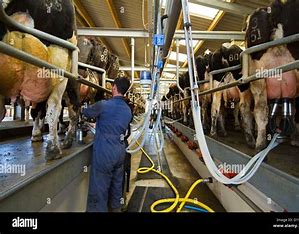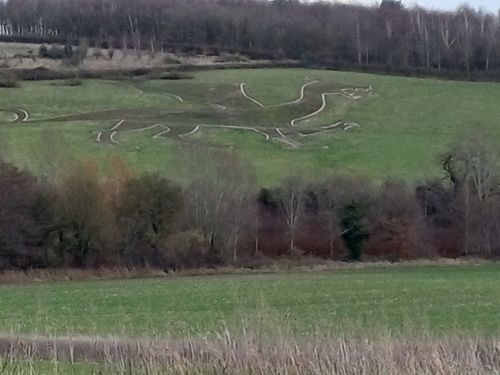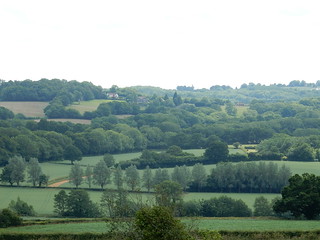The Church at Fobbing is peaceful this morning; no bells are ringing today. Despite the tranquility, I should have taken the bell ringing of yesterday as an omen. This day was going to be more eventful than I anticipated.
I have had to choose my route with care. According to the OS map, a number of footpaths lead away from Fobbing and it would be easy to go in the wrong direction. I walk down the road and find a footpath sign. This seems to go the right way and, hoping this is the correct path, I set off. The route winds behind the gardens of residential houses and then follows a raised bank through farmers fields.
It is still early, just after ten o’clock on this Saturday morning. The sky is overcast and the light is dull. I meet nobody.
 Ahead, between clumps of hawthorn bushes, I can see the oil refinery in the distance. Pylons surround me, carrying electricity to the industrial complex, where the refinery spreads itself along the river bank. It is this oil refinery that blocks my coastal route. There is no public footpath along the estuary here. So, I am heading southwesterly, hoping to rejoin the Thames further along, where a path runs uninterrupted along the river bank, all the way to Tilbury.
Ahead, between clumps of hawthorn bushes, I can see the oil refinery in the distance. Pylons surround me, carrying electricity to the industrial complex, where the refinery spreads itself along the river bank. It is this oil refinery that blocks my coastal route. There is no public footpath along the estuary here. So, I am heading southwesterly, hoping to rejoin the Thames further along, where a path runs uninterrupted along the river bank, all the way to Tilbury.
The ground is a little muddy. I use my poles and am surprised at the rapid progress I make. My balance on the slippery ground is improved, the poles seem to take pressure off my ankles and the muscles of my arms propel me forward at increased speed. This is wonderful!
It is some time before I realise I am on the wrong footpath.
 I reach a dual carriageway that leads to the oil refinery. Luckily, this road has a good pavement alongside it and the traffic is surprisingly light, with only an occasional tanker or lorry rumbling past. I would like to take a side road off to the south, cutting across countryside to meet the bank of the Thames. But the roads all carry warning signs – no access and closed circuit TV in operation. I walk back along the side of the road, feeling a bit foolish walking with my poles on the firm surface of the pavement.
I reach a dual carriageway that leads to the oil refinery. Luckily, this road has a good pavement alongside it and the traffic is surprisingly light, with only an occasional tanker or lorry rumbling past. I would like to take a side road off to the south, cutting across countryside to meet the bank of the Thames. But the roads all carry warning signs – no access and closed circuit TV in operation. I walk back along the side of the road, feeling a bit foolish walking with my poles on the firm surface of the pavement.
Eventually I find the footpath I am looking for, near a building called “Old Hall” and set off down a track that leads to Oak Farm. There are a few dog walkers out now and I feel slightly self-conscious about my poles. Any embarrassment I may have about looking a bit eccentric soon wears off, as I make rapid progress.
 Then I come across a large puddle, flooding the track from hedge to hedge; more of a pond than a puddle. A friendly cyclist passes, waving to me and sailing through the puddle with ease. I envy him his two wheels. Sticking as close to the shallow edge as I can, I fight off the hedge with one pole, while keeping my balance with the other pole, and manage to make my way along the side of the puddle. My boots get a little wet, but not wet enough to dampen my socks. I thank my useful poles.
Then I come across a large puddle, flooding the track from hedge to hedge; more of a pond than a puddle. A friendly cyclist passes, waving to me and sailing through the puddle with ease. I envy him his two wheels. Sticking as close to the shallow edge as I can, I fight off the hedge with one pole, while keeping my balance with the other pole, and manage to make my way along the side of the puddle. My boots get a little wet, but not wet enough to dampen my socks. I thank my useful poles.
This track, if I continued along it, would lead straight to the river bank. But, according to the map, there is no continuous right of way along the bank at this point. Instead, the footpath loops back on itself, heading inland again. So, unable to take the direct route, I have planned an alternative route along footpaths and tracks. It seems a long time since I left the sea behind at Southend and I am still a long way from regaining my coastal route.
Now, I cut across fields, following a public right of way, to meet another track, taking me under a railway line. I find a well signed path, leading off to the right, passing a fishing pond and leading down a wide, gravel road. I have gone some distance along this route before I realise that I am on the wrong path, again.
Doubling back, I find the right path; an overgrown footpath, hard to spot, that leads to a lovely broad walk, running through a nature reserve. The fishing pond is on my left, with marshes to my right. I see no birds but meet a couple of bird watchers.
I reach the village of Mucking and the footpath runs alongside some rather nice houses until I reach a tarmac road. Past the church and over a railway crossing, I reach a busier road and turn left towards the village of Linford.
There is no footpath and the road is narrow with tight bends. I walk facing oncoming traffic, except when approaching a blind bend, when I cross over to the side that gives the maximum visibility. A couple of workmen on the side of the road warn me to be careful of the traffic. This is pretty pointless advice – I am being as careful as possible.
I am passed by a boy cyclist. He cycles with one hand in his back pocket and the other on his mobile phone, which he is using to send text messages. He looks very stylish. But he is not touching his handlebars and wobbles dangerously when he comes to a bend. Later, I am overtaken by a young man travelling much too fast in a small hatchback car. I hope the cyclist ahead is OK.
When I reach Linford (without coming across any squashed cyclists on the way), I turn left again along the road, walking on the pavement. Feeling a bit foolish with my poles in my hand, I fold them away and stow them on the back of my rucksack, where they poke out at the sides, threatening grevious bodily harm to anyone who gets too close to me.
Ahead is a pub. It is early, only just twelve o’clock midday, but this is where I intend to have lunch. There are CCTV cameras in the pub car park and warning signs about violence; not a very reassuring welcome. I go in the door marked “lounge” and find myself in a large, empty bar with a couple of enormous flat screen TVs showing a football match. There are no customers and no bar staff. I come out again and go in another door marked “bar”. Now I am at the other end of the same large, empty bar; still nobody but, as I stand and wait, a barmaid emerges. She is a little flustered to have such an early customer.
The only food they do on a Saturday is “roast dinner”. I order lamb. It is off. The butcher has not arrived yet. But the cook, who is round and plump as a good cook should be, offers me an off-menu alternative of lamb pudding. This is tasty and I enjoy it very much, while watching the football match.
Having made good progress so far, I decide to lengthen my walk by heading eastwards to pick up the river bank footpath before it winds round to meet the end of this road at Coalhouse Fort.
First, a disappointment awaits me. One of my poles is broken. It telescopes out, but doesn’t stop lengthening and comes apart. When I reinsert the bottom half of the pole into the upper segment, the mechanism for locking the pole at the right length appears to be broken. The other pole is fine. I stow away the broken pole. Now the rhythm of my walking is altered; I am lopsided.
 The path to the river bank winds around the back of a housing estate, passing through a narrow avenue of blackberry hedges, until I reach a fenced off area. This is Mucking Tip. Somewhat bizarrely, given the remoteness of the site, there is a planning application stuck to the fence. From reading this bright yellow sign, I gather the old tip has machinery to harvest gas from the decomposing rubbish. The eventual plan is for Essex Wildlife Trust to turn this disused tip into nature reserve . I hope, when they do so, they will restore a proper coastal walk to this area of Essex.
The path to the river bank winds around the back of a housing estate, passing through a narrow avenue of blackberry hedges, until I reach a fenced off area. This is Mucking Tip. Somewhat bizarrely, given the remoteness of the site, there is a planning application stuck to the fence. From reading this bright yellow sign, I gather the old tip has machinery to harvest gas from the decomposing rubbish. The eventual plan is for Essex Wildlife Trust to turn this disused tip into nature reserve . I hope, when they do so, they will restore a proper coastal walk to this area of Essex.
I reach the river wall; a high bank with a concrete wall on top. I climb up, relieved to be back near water again; although I have to stand on my tiptoes to see over the wall.
The view is not entirely scenic. There is litter on the river bank, brought ashore by the tides in the estuary.
To my left I can look towards the mouth of the Thames and the open sea. There is an old jetty and large cranes. Here is where rubbish was unloaded from large barges, at Mucking Tip.

To my right, the wall winds around, following the north bank of the River Thames, leading towards Tilbury docks and London beyond. There are large ships making their way up towards the docks. I can see the far side of the river.
 One day, I shall be walking along that far bank.
One day, I shall be walking along that far bank.
Now, I walk along the concrete platform that runs at the base of the wall, next to the river itself. I pass a couple of fishermen and some bird watchers. The pathway is narrow. Walking past people is somewhat awkward, involving a sideways shuffle, as I try and avoid their fishing tackle while simultaneously trying to avoid stabbing them with my pole.
 After some time, round a long, curving bend of wall, I see Coalhouse Fort ahead of me. Here the wall disappears and there is a pleasant open area of greenery and an inland boating pond. Families are out. Fathers are sailing boats on the pond while their children watch.
After some time, round a long, curving bend of wall, I see Coalhouse Fort ahead of me. Here the wall disappears and there is a pleasant open area of greenery and an inland boating pond. Families are out. Fathers are sailing boats on the pond while their children watch.
The Fort itself is closed. But the small information office is open.
I am looking for Peter Caton’s book, Essex Coast Walk, and I believe it is for sale here. Proceeds go to the Essex Wildlife Trust, who are planning to renovate the Mucking Tip landfill site. So I am keen to buy this book, not only to support the Essex Wildlife Trust, but because I am really interested to find out more about Peter’s adventures walking the Essex coastline.
The little office is hot. There is a fan heater going at full blast. I am wrapped up in a fleece and jacket with my rucksack on top. It is chilly outside and, at first, I welcome the feeling of warmth. An elderly gentleman is in the middle of the room and is talking about his war adventures. After waiting 10 minutes, during which time I become hotter and hotter, I decide to leave, having been unable to spot Peter Caton’s book in the little display area. I am tired and thirsty and, with the heat in this place, I feel I am about to faint.
The attendant, perhaps seeing my impatience despite my trying to hide it, puts his hand on the old gentleman’s elbow.
“Well, we are here every day and you are welcome to come back and tell us more about it,” he says, gently and tactfully. With great grace he opens the door, ushers the elderly gentleman through and closes the door behind him. Reaching up he flicks off the heater.
I suppress a sigh with relief. He apologises for the delay, but, no, he doesn’t have Peter Clayton’s book. He kindly gives me a number of leaflets and brochures, explaining the history of Coalhouse Fort and offers me a very useful little map of local walks. I explain my journey round the coast. He tells me I can walk to Tilbury ferry crossing from here, passing by the power station on the way.
“Or, if you walk into the village, you may be able to catch a bus.”
“I am not allowed to travel by bus,” I tell him.
If he thinks this is a little odd, he is too polite to say so.
I leave the shelter of this friendly office and head back along the river Thames, walking westwards towards London.
 For a moment, the sun comes out, and lights up Coalhouse Fort and the fields around it. The current Fort is not old, most of its construction dates from the 19th Century and was added to during the World Wars of the 20th Century. There has, however, been fortifications on this site for many hundreds of years, starting in the 15th Century. You can view a timeline for the fort and see that this was always an important defensive area, overlooking the mouth of the Thames.
For a moment, the sun comes out, and lights up Coalhouse Fort and the fields around it. The current Fort is not old, most of its construction dates from the 19th Century and was added to during the World Wars of the 20th Century. There has, however, been fortifications on this site for many hundreds of years, starting in the 15th Century. You can view a timeline for the fort and see that this was always an important defensive area, overlooking the mouth of the Thames.
To my left, flows the mighty Thames; with its water a greenish grey under the overcast sky. There are more fortifications and a look-out post. To my right are fields and I see a tractor ploughing with a huge flock of seagulls following behind it.

Around Coalhouse Fort there were families on outings. Now the path becomes lonelier. I meet a cyclist and he asks me where I am heading. Tilbury Ferry? Then I can walk along the river by the power station.
“It is not a public footpath,” he tells me. “But everybody walks along there.”
 The path crosses wasteland. I notice some rather fine ink cap fungi growing and take photographs. I wonder if they are edible.
The path crosses wasteland. I notice some rather fine ink cap fungi growing and take photographs. I wonder if they are edible.
Now I find something odd. The ground I am walking over is rough and there is broken glass strewn over it. At first I wonder if there has been an illicit party here – maybe a “rave” event. But there is no other signs of party goers, no beer cans or other rubbish; just broken glass and occasionally a smashed piece of crockery. Some of the glass fragments, near the shore line, have been worn smooth by the river tides. I walk for hundreds of yards, over land covered in smashed glass. How very strange!
 Ahead looms the Tilbury power station.
Ahead looms the Tilbury power station.
I am looking forward to this section of the walk. I enjoy industrial scenery. This is one of a number of power stations I have come across on my coastal route; Sizewell and Bradwell were the others.
The official public footpath deviates inland, around the power station. But there is another path, well trodden, that leads down to the riverside.
 Here the path runs along the edge of the water, a concrete walkway along the tall, forbidding wall that marks the edge of the power station itself. I feel a little like a trespasser and am relieved to meet nobody on this narrow path.
Here the path runs along the edge of the water, a concrete walkway along the tall, forbidding wall that marks the edge of the power station itself. I feel a little like a trespasser and am relieved to meet nobody on this narrow path.
David Cotton was interested by some of the graffitti he saw on this wall when he walked this section of the coastal walk. I love good graffitti as a form of art work. Sadly, there is nothing to see today; it must have been power-cleaned away.
 There is a noise, a kind of low-pitched hum.
There is a noise, a kind of low-pitched hum.
I round the corner and see a jetty with a large ship moored alongside and a connecting structure linking it to the power station. I pass under this structure. There is something happening on the ship; machinery is operating and there are workmen around. I suspect they are unloading fuel for use by the station, but am not sure.
I continue along the narrow walkway and around the edge of the power station boundary. Now I see a green, open space ahead. Having walked alone since I met the cyclist an hour or so ago, I now meet fishermen, dog walkers, and a father on a quad bike with his son behind him.
A chatty fisherman asks me where I have walked from. Then he explains I have walked across an area where there used to be an old glass tip. A glass tip! That explains the mystery of all the broken glass on the ground.
Beyond here is another coastal fortification, Tilbury Fort.
I see large guns and people wandering along the walls. I would have stopped to look, but I am growing tired and am anxious to find the Ferry crossing before it closes for the evening.
No time to rest ….
This was a very eventful day and I have split the walk into two sections.
a) Essex – before the Ferry.
b) Kent – Ferry crossing and Gravesend.
While trying to find out more about the glass tip, I discovered this blog Rambling on by an American, Mary Kadzielski. She describes the same walk and says the tip was a Victorian dump and, as it is gradually eroded by the Thames, is delivering up its hidden contents, including human bones. I must say, I did not come across any bones – but then I wasn’t looking for bones.









The glass near Tilbury power station is an old rubbish tip dating back to Victorian times.
Interesting to read your Fobbing to Tilbury section. I live locally and did not realise you could do that. I might even go down there today to look for some victorian bottles.
Hi Colin
Good luck with your bottle hunting 🙂 Would be interested to hear if you find anything interesting on the tip. My memory is of smashed up glass and pottery.